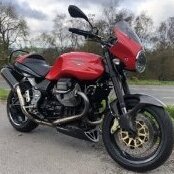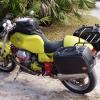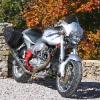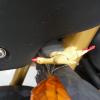Leaderboard
Popular Content
Showing content with the highest reputation on 11/23/2020 in all areas
-
2 points
-
Wow, man what a kindness! Thank you, Sir! This was my mostest-worstest oil change of all thirty. Drain plug pulled its threads out in bits/ first stuck oil filter, ever/ sump fastener that holds the left side, rear aspect of the sidestand index plate pulled its threads (all in one coiled mass). As many of you already know (or suspect), when my Sport goes down (for whatever reason), I become, er, rather afflicted . . . My local (O'Reilly) auto parts store had the full M10-1.50 Stanley "Heli-Coil" kit for the drain plug. Heat gun and a friction surface (100grit paper) inside a strap wrench had the crumpled filter loose. Come first thing Monday morning, my local "Fastenal" store set me up with the M6-1.0 repair kit for the sump. It was really sketchy to get the Sport jacked high enough, then drill and (STI) tap the hole vertically upward. So, nope, standard M6 tapping will not work; must be "STI." I did, finally, prevail and had the Sport back in action in under 48 hours. The upwardly drilled hole is not perfectly aligned, but stabilized the sidestand plate and the sump does not leak. Once again, @Bob Maynard , thank you kindly for the generous and trusting offer of help!2 points
-
Thanks. That's the Shirley Meeting House in Shirley MA, a stopping point in one of my local ride loops. http://www.shirleymeetinghouse.org/ https://goo.gl/maps/cLv2SqAFmNTTDzwK8 Thursday was pretty warm for November, 64F, and the roads clear, so I took one more 2020 ride before winter fix-up time ... tank-off service, driveshaft service, and so on ... .2 points
-
Whenever I read a write-up on a product, I always wonder about the CV of the writer and what kind of rider they are. So; In almost all groups I have spent any significant time with, I have tended to find myself the lead navigator, be it on foot, cycle, motorcycle or car. From a young age (7 in 1972) I did milk rounds with my Dad on Saturdays (and school holidays) and he being a supervisor, saw over four different rounds. So I learnt my way around Gravesham early and was always taking my friends on cycle rides that looking back probably would have made their parents cringe had they known or actually believed the stories their child told. This carried me through my ATC years where I learnt to map read in conjunction with the sun, setting me right for my outward bound hiking adventures and of course into motorcycling in the UK and €pe. 2005 and I find myself out of work and I take up a 5 year stint as a courier. Armed with A-Z on Manchester, Liverpool, Sheffield, Leeds & London on board, complimented with a top notch UK road atlas with city centre maps, I would have to be going out into the wilds to call on my phones sat-nav capabilities. I always found that once I found an address by maps, I wouldn’t need the map again. Go by Sat-nav and I would need to use the Sat-nav next time too (just as I can never remember a route someone else has led), so Sat-navs have never really been a thing for me. Then there was the spaghetti of wiring that is still required by Tom-toms and Garmins today. Plus the empty cradles for said make the bikes dash look like a cannibalized cyborg. Then there is the security at your destination, carrying £300+ of waterproof Sat-Nav with you while sightseeing. Read through our forum and you’ll find a plenty the question asked, “Which is the current best Sat-Nav” to which you’ll frequently find my response, “A map”. By now you’ll probably gather I am not a Sat-Nav fan. However, in 2015 events conspired that I headed off on holiday with a bunch of strangers (then) who were going by Sat-nav. They put on a very good tour, but they didn’t just tell the Sat-Nav the destination and follow it. They used a technique I use when planning a ride, only they to a far greater extent. I will jump on google maps and at every junction I will go on street view and ride the junction virtually (on line) finding visual land marks. They go further, and ride the whole route and ditch a road if it is too straight or too rough. I have since toured with them twice more and I started to see the merits of a Sat-Nav used as an aid, rather than a guide. 2020 and lockdown is in full swing and I am browsing Tom-toms and Garmins and trying to justify £300-400+ for something that would only get occasion use, and then only for small segments of my Sunday rides. Having ridden out from Manchester for closing on 20 years and establish multiple routes to any point on the compass, my routes tend to avoid towns have few road changes and be on B-roads. But after said 20 years of Sunday ride-outs, even this variety of destinations spanning from Builth Wells to Skegness to Kielder water gets repetitive. However I know there are a multitude of good minor roads to explore in between, they are just awkward to navigate between. Hence considering a dreaded Sat-Nav. So to the Beeline Then all of a sudden I discover the “Beeline.co”. A third the price of a regular motorcycle Sat-nav, it is unobtrusive on the bar or mirror stalk and removed from the bike, is so small and light to carry, easily in a jeans pocket, bumbag with a phone and wallet in it or in the Mrs’ clutch bag. The Beeline offers turn by turn navigation directions in a simple format. In truth it is not actually a Sat-Nav at all in my opinion. It is a second screen for your phone that is rated to IP68. That means it is dust proof and water proof to a depth of one meter (or one yard). It connects to a smart phone by blue tooth, upon which is installed the Beeline navigation app for which the Beeline unit has like a software key (or dongle) to activate the app. A destination is input into the phone and way points can be added. Then press “Go” and the Beeline screen starts dishing out the directions as the route is progresses. It is possible to offset the starting point. This means a route can be planned from a future start point days or months into the future. Not much different to a conventional Sat-nav I hear the cry! Well here’s the differences, which can be positive or negative depending on view points; * There is no limit on maps. It will work anywhere in the world where a phone location can be accessed. * The display does not show a plan view map. It has a simple arrow showing the way to go plus a distance to the next turn, junction, roundabout, waypoint or destination (whichever is next). On a Garmin in the top corner you get similar information that is displayed on the Beeline. * There is no audible notifications (which can be bliss). * There is no cabling on the handlebars. The beeline has a 30 hour in use battery life. That is three days solid riding by anyone’s standard and the charger is compact and plugs into any USB port. * Data usage is suprisingly low. My sim-only package has 1GB of data per month and a good spin round Wales barely showed on the data graph. * Phone battery usage, well my phone is getting on and didn’t have the longest life from new. I have wired a USB port under the seat of my Nevada so that the phone is on constant charge. That said I have run it for a few hours on a full charge and it zapped 40%, but I can do a similar drain with social media over the same time span. In the images you can see that which appears on the phone. My start point in the east in Heathersage and the end point in the west in Denton Manchester with some northern waypoints I used to false the route. At the start I was on the far side of a car park and the Beeline is guiding 47 metres to the road. In the other shot on route you can see I am 8.9 miles from a roundabout, where I am to take the second exit. The white dot at one o’clock tells me the exit is just to the right of straight on. The faint grid lines tell me I am approximately half way through my total journey. On my motorway the roundabout symbol is replaced by a motorway junction symbol and junction number. I put this route together over a breakfast without a map or accessing the internet. The route the Beeline led me was true to my input. Unfortunately, I did not pay enough attention to my last way point and it took me up a lane to a goat trail. On the XPA I may well have gone with it, but on the V11 I decided better of it. This is the second time I have made this mistake of not taking enough time over the sections of the journey I am familiar with. A few weeks ago I had a ride-out with some fellow Pennine Guzzisti in N. Wales. On that trip I researched the first 75% of the trip which consisted of a whole heap of turns across minor roads that I had not ridden prior and would not have attempted with company in the past. The last 25%, knowing basically where I expected to go, my attention to detail was not so hot. At least the first 75% of the route went very well indeed. Three features I have not mentioned; 1. Up until now I have been reviewing “Route mode”. There is also “Compass mode”. I mentally discarded this as only really useful for off-road riding such as riding green lanes. However, it does come into its’ own when things go wrong, such as a road closed or Sat-nav pilot error. Switching to compass mode, the Beeline will simply point to the next destination, keeping you orientated whilst trying to find an alternative routes. A typical Sat-nav will just point you back to the problem until you are far enough away that an alternative route is calculated. 2. Importing of .gpx files (which is the cross platform file type for navigation devices such as Garmin or Tomtom) can be done. On my very first ride with a Beeline I did this and switched it off after 3 miles of 330. This is probably going to turn out to be my error too. I will try again at a later date. 3. The Beeline Moto, is a development of the Beeline Velo for cyclists. The option to go Velo seems to be there and as I do a little, I shall be exploring it. Lastly, the Beeline display options. As well as displaying the route, you can scroll through options on the Beeline unit without out your phone to hand, and display the time, your speed and the battery state of the beeline and your phone. The speed display might be useful for some machine with where speedo parts are scant. You can probably already see this device is not for all. If you are looking for a navigation nanny, this device is not for you. If you are looking for a device you are going to use as an occupational tour guide, this probably is not for you. For occasional use? For minimum handlebar clutter and minimal off bike baggage? Looking for a navigation aid/memory prompt? Looking for budget Sat-nav? If the answer to any of these is “yes”, then the Beeline may be for you. “Hang on”, I hear the cry, “why not just use a smart phone in a handlebar clamp”? Well you need an IP67 rated phone at least for all weather use and a Mechano kit of clutter on your bar to hold it. A phone with those specs is likely north of £300 on your bar, making it attractive to thieves and if you have an off, your means of communication is pretty vulnerable, as is your contacts list, banking details and loads of other data. The Beeline can be viewed as a sacrificial unit that has a relatively low cost to any other techno alternative and less inconvinient to lose or break. It was my choice and not a bad one “for me”. Certainly won’t be right for all. Moderator/Administrator, I could not get this image to display. Feel free to share. If you copy the whole lot in to your browser it will work. https://scontent-lht6-1.xx.fbcdn.net/v/t1.0-9/126956950_3726475370738176_8378252657882387746_o.jpg?_nc_cat=103&ccb=2&_nc_sid=730e14&_nc_ohc=ff24Pon_uPwAX_tZO_s&_nc_ht=scontent-lht6-1.xx&oh=8942be66edc0d3ec9624b968a147cc63&oe=5FE04DEE [img]https://i.postimg.cc/Wp0c6hqz/DSC-0438.jpg[/img]1 point
-
The small scale at the top is an indication of one's progress through the programmed journey.1 point
-
In most photo programs, you will see Direct, BB (bulletin board) code.. it has the .img.. and HTML. After the latest upgrade to this site, BB no longer works, and you have to choose "Direct."1 point
-
1 point
-
Regarding the photo. The big arrow pointing straight ahead means you're going on the route, it would point away in the wrong direction if you weren't. The small dot on the right means your next turn will be a right turn and 8.9 miles means the right turn is 8.9 miles ahead. The small scale indicates whether it's a hard right turn or a slighter turn such as a fork in the road or roundabout. Pretty intuitive. If you get off course, press the yellow button will recalculate to get you back on route. Or just continue to ride and follow the arrow until you find your way back to the route. In compass mode the arrow points in direction of destination.1 point
-
You have to use the "Direct" option instead of img.1 point
-
Docc, I have the same stripped sump bolt issue, and have the helicoil kit I purchased/used for another bike. STI Bottoming tap and installation tool included. Not included is 1/4” drill bit needed. I can send to you if you will return it to me before I need to change the oil filter in the springtime. No hurry, I need to acquire the courage and a right angle drill before I start this repair. Bob1 point
-
I've had my Beeline for a couple of months. Got it from a member of the Wild Guzzi board who never took it out of the box. The unit works as advertised. I've test ridden compass and point to point. Since the Covid deal started, I've not done any overnight travel and put it through all the paces. I've only done a couple of test runs with it. So there maybe other pros and cons and I'll likely have to refresh myself how to build routes. I like the minimalist approach. It's about the size of wristwatch face. I can mount it with rubber bands on my bars and there are some adhesive mount options. The small unit snaps off the mounting base. The charging unit has a similar snap on base with a USB charge cable that fits into a phone charger plug. In operations, there is a pointer that gives directions, it will also countdown the distance to the next route turn. The pointer will point the other way if you miss a turn. You can also hit the button to reroute if you miss a turn or want to change your route and get you back on course. In compass mode the the pointer shows the direction and posts the approximate distance to the destination. No phone or GPS on the dash, no phone directions shouted in your ear. Just ride like normal and take a peak at the dial. Being a guy that uses route notes and tankbag maps, this is the deal I like. I suppose I could mount it on the plastic cover on the tankbag with the adhesive mount. I prefer the rubber bands, moving it from bike to bike. The phone app has a few glitches however. The bicycle routes have been the best for most pleasure riding. In fact, it posted the exact route I ride for 300+ miles from my door to Jasper Ark. The motorcycle option is glitchy. I wrote Beeline about it and they confirmed that. One hint, if you want to build a route, you'll have to go step by step, point to point; don't start with your final destination and then try to modify the route. There is also the possibility of building a route in another program, like google maps, and saving it to the readable format (gpx- thanks Cab) downloading it to my phone but I'm not up to speed with that.1 point
-
0 points






